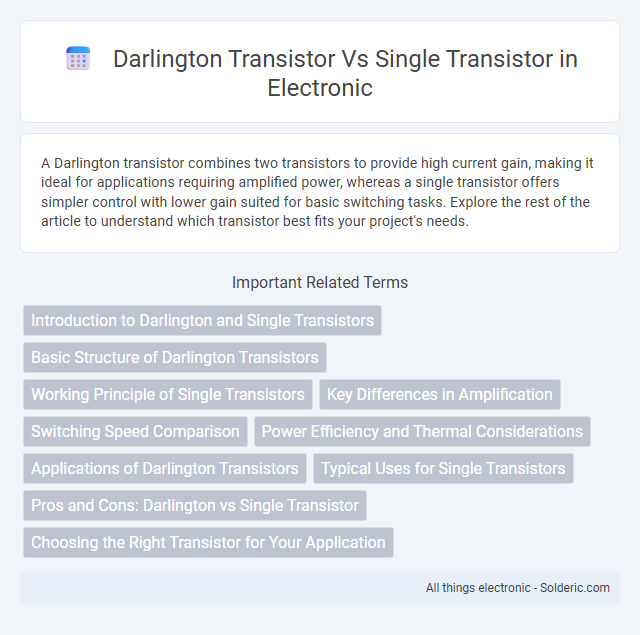A Darlington transistor combines two transistors to provide high current gain, making it ideal for applications requiring amplified power, whereas a single transistor offers simpler control with lower gain suited for basic switching tasks. Explore the rest of the article to understand which transistor best fits your project's needs.
Comparison Table
| Feature | Darlington Transistor | Single Transistor |
|---|---|---|
| Structure | Two transistors connected in cascade (compound transistor) | Single transistor with one transistor element |
| Current Gain (b) | High current gain (b total b1 x b2) | Moderate current gain (b varies by type) |
| Saturation Voltage (Vce(sat)) | Higher saturation voltage (~1.2V to 2V) | Lower saturation voltage (~0.1V to 0.3V) |
| Switching Speed | Slower switching due to dual junctions | Faster switching time |
| Input Impedance | Very high input impedance | Moderate input impedance |
| Applications | High current gain amplification, power switching | General amplification, switching |
| Package Size | Usually larger due to two transistors | Smaller, single transistor package |
Introduction to Darlington and Single Transistors
A Darlington transistor consists of two bipolar transistors connected to provide a high current gain, significantly greater than that of a single transistor. Single transistors, typically used individually, offer lower current gain and simpler circuit design. The Darlington configuration is widely favored in applications requiring amplification of weak signals and high input impedance.
Basic Structure of Darlington Transistors
A Darlington transistor consists of two bipolar transistors connected in such a way that the current amplified by the first is further amplified by the second, resulting in a much higher current gain compared to a single transistor. Its basic structure features two transistors sharing a common base terminal, with the emitter of the first transistor connected to the base of the second, effectively creating a compound transistor. This design allows Your circuits to achieve higher sensitivity and amplification with minimal input current.
Working Principle of Single Transistors
Single transistors operate by using a small input current at the base to control a larger current flow between the collector and emitter, functioning as a current amplifier. Unlike Darlington transistors, which consist of two transistors connected to provide higher current gain, a single transistor offers simpler control with moderate amplification. Your circuit design benefits from understanding that single transistors switch or amplify signals based on the semiconductor material's properties and transistor junction behavior.
Key Differences in Amplification
Darlington transistors consist of two bipolar transistors connected to provide a much higher current gain than a single transistor, making them ideal for applications requiring significant amplification with minimal input current. Single transistors offer a moderate gain, which is sufficient for less demanding amplification tasks and simpler circuits, but they require higher input current to achieve similar output levels. Your choice depends on whether you need high sensitivity and strong current amplification or simpler, low-gain operation.
Switching Speed Comparison
Darlington transistors exhibit slower switching speeds compared to single transistors due to their two-stage amplification process, which introduces additional delay and increased capacitance. Single transistors switch faster because they have fewer internal junctions and lower charge storage, enabling quicker transitions between on and off states. When optimizing for high-speed switching in your circuits, selecting a single transistor often provides better performance and more efficient signal response.
Power Efficiency and Thermal Considerations
Darlington transistors offer higher current gain compared to single transistors, which improves power efficiency by reducing the base current and minimizing drive power requirements in high-load applications. However, the increased saturation voltage in Darlington pairs leads to greater power dissipation, necessitating enhanced thermal management such as larger heat sinks or advanced cooling solutions. Single transistors, with lower saturation voltage, generally exhibit better thermal performance and lower heat generation but require higher base current for the same output current, impacting overall efficiency.
Applications of Darlington Transistors
Darlington transistors are widely used in applications requiring high current gain and sensitivity, such as in power amplifiers, motor controllers, and relay drivers. Their configuration of two transistors in a single package allows for amplification of weak signals without the need for additional components. This makes Darlington transistors ideal for switching and amplification tasks in automotive electronics, audio devices, and industrial control systems.
Typical Uses for Single Transistors
Single transistors are commonly used in low-power amplification, switching applications, and signal processing where simplicity and cost-effectiveness are essential. They serve as fundamental building blocks in analog circuits, such as audio amplifiers or basic switching devices in microcontroller interfaces. Your projects benefit from single transistors when compact, reliable control of small currents is required without the complexity of multiple transistor arrangements like Darlington pairs.
Pros and Cons: Darlington vs Single Transistor
Darlington transistors offer significantly higher current gain compared to single transistors, making them ideal for applications requiring high amplification with minimal input current. However, Darlington pairs suffer from a higher saturation voltage and slower switching speeds, resulting in increased power dissipation and reduced efficiency in high-frequency circuits. Single transistors provide faster switching and lower voltage drop but require more base drive current to achieve comparable gain, making them more suitable for low-power, high-speed applications.
Choosing the Right Transistor for Your Application
Darlington transistors feature two transistors connected to provide high current gain, making them ideal for applications requiring amplified power with minimal input current. Single transistors offer simpler design and faster switching speeds, suitable for low-power or high-frequency circuits where efficiency and response time are critical. Understanding the specific current, voltage, and switching requirements of your application helps you select between a Darlington transistor's enhanced gain or a single transistor's streamlined performance.
Darlington transistor vs Single transistor Infographic

 solderic.com
solderic.com